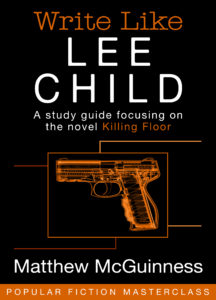Every novel is a bargain with the reader – an agreement that says the author is going to package up and deliver certain types of descriptive detail, and in exchange the reader is going to accept it as a real world. It’s what we love more than anything else about the experience of reading fiction – that willing self-immersion in a made-up universe. Given the importance of sealing this literary contract, it’s surprising that readers are so flexible over what they’re willing to accept as ‘real’. By that, I don’t mean they’re willing to accept fantasy worlds as well as more familiar worlds. I mean they’re willing to accept rather vague and undetailed worlds as well as highly specific and detailed worlds. You could, no doubt, come up with numerous examples from your own reading to prove that point. But, allow me to focus on two books: It by Stephen King (the novel I’m currently writing about) and Killing Floor by Lee Child (the last novel I wrote about).
This may sound odd, but Stephen King’s novel, for the most part, comes across as ultra-realistic. You can open it at almost any page and find a passage that would make a very good case study of descriptive technique for a creative writing class. It’s specific but economical. It covers all the senses, but always focuses on the most evocative sense for a particular situation. One of the defining characteristics is the large number of popular cultural references. King gives us everything from TV shows to kids’ insults – the whole fabric of young lives in the 1950s. By contrast, as readers of my book on Killing Floor will know, Lee Child is very sparing with his description. The world of the novel feels thin, like a stage set. While the details are conveyed just as vividly as Stephen King’s, they are nothing like as varied or plentiful.
Don’t misunderstand me. Both writers are equally great. Their respective styles of realism are not indications of superior or inferior skill. They’ve simply made different creative decisions that affect their style of realism.
Those creative decisions are, to a large extent, determined by the genres that the two authors are writing in. In King’s case, he is telling a supernatural thriller story. Like many supernatural thrillers, it contains elements of wild fantasy – stuff that is totally beyond our real experience. Strangely, that makes it necessary to first establish with absolute clarity, a world that closely resembles our own. If you think for a moment, you’ll realise that the episodes of supernatural horror in It would be much less shocking if they weren’t shattering a fairly humdrum world.
That’s the most obvious reason for King’s ultra-realism. There’s also a slightly less obvious explanation. Basically, King needs us to empathise strongly with the main characters in order to get worried about them. Worry is an essential part of a good thriller. And one of the best ways of promoting concern for literary characters is to show us how much we have in common with them. Most readers will see some TV programme or comic mentioned in It that they’re familiar with – even if it’s only the ‘Lone Ranger’. If they were born in the mid-twentieth century, they might even remember using the same kind of playground language as the kids in the novel. With that kind of kinship, it’s inevitable that we’re going to be anxious for them when they’re in peril.
The need to make us empathise as much as possible with each of the various fictional children is particularlyurgent because there is no one ‘hero’ in It. There are lots of characters whose thoughts we enter and follow for a while. Sometimes we barely get to know them before they die horribly. As a result, King does whatever he can to make us rapidly connect with them. That includes providing an in-depth guided tour of their popular cultural preferences as well as their physical and psychological environment.
Lee Child presents us with just one hero – Jack Reacher. Consequently, there’s nothing like as much personal detail supplied. We barely know five facts about his biography by the end of Killing Floor. It’s true that we receive a drip feed of information about his military skills throughout the novel, but those titbits are only ever provided to drive the narrative forward. Contrast that with the waterfall of colourful details that serve no narrative purpose in It. The evocation of Reacher is not only thinner than the description of the kids in It, but also a less anchored in the real world. He’s not a superhero or a creature of pure fantasy, however. He’s a sort of hybrid – a filtered, simplified and somewhat enhanced collection of human traits.
The world that Reacher inhabits has a similarly hybrid realism. It references familiar things, but only those things that can be exploited for their for symbolic resonance. The town of Margrave exists to make us reflect on aspects of wealth and power. The description of its semi-real landscape of political statues and posh suburbs is honed to achieve that effect. Lee Child deliberately withholds all detail that doesn’t contribute to it.
As you can see, different types of realism can serve different literary purposes. If you’re working on your own novel, think about the type of realism you’re evoking. Does it help to convey meaning or hinder it? Should you increase or decrease the level of detail? Have you thought about the particular types of detail you should be focusing on?



